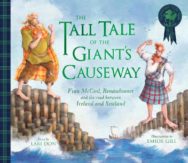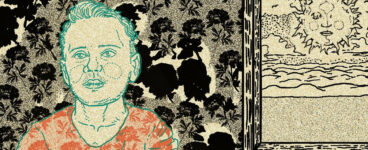‘Folklore is constantly evolving, and I hope that evolution will keep these wonderful flexible stories relevant all the way from ‘once upon a time’ to a far-distant ‘happy ever after’… ‘
Following Irish and Scottish giants Finn McCool and Benandonner, who want to know who is the best giant, but first must cross the Irish sea, we asked author Lari Don to tell Books from Scotland just why folk tales still matter, and what inspiration we take from these variations of tried and tested tales as we venture with them into the Giant’s Causeway.
The Tall Tale of the Giant’s Causeway
By Lari Don, illustrated by Emilie Gill
Published by Floris Books
Folklore is the fertile ground in which my own stories grow. Almost all of the children’s books I’ve written are retellings of traditional tales – folktales, fairy tales, myths, legends – or have been inspired by them.
Why is folklore so inspiring, and are traditional tales still relevant today?
Traditional tales are reliable building blocks for much of our culture, including many forms of storytelling – books, films, computer games – which didn’t exist when these tales were first told. We are fascinated by these old stories because they still give us, as individuals and as communities, something we want and need. Traditional tales continue to be relevant because they’re not static. Folklore evolves, to fit tellers, audiences, circumstances. The stories which last are the stories which are flexible, the ones which can change to fit new worlds.
How do folktales evolve? Here’s an example.
My new book, The Tall Tale of the Giant’s Causeway, retells the story of the Irish giant Finn McCool and the Scottish giant Benandonner arguing across the sea, then building a causeway so they can meet and fight. Their rivalry is resolved without an actual fight because Finn’s wife Oona comes up with a clever trick involving Finn dressed up as a baby. It’s a well-known tale, with dramatic and funny imagery, beautifully brought to life in our book by Emilie Gill’s fantastic illustrations. My retelling aims to balance respect for the original story and consideration for my modern audience. So I tweaked the story a wee bit. This is an Irish folktale with one Scottish character, and it usually ends with the daft Scottish giant running away, leaving the Irish giants victorious. Bearing in mind that the likely audience contains a fair few Scottish picture book fans, I wanted to retell it in a more even-handed way. So I didn’t end the story at the traditional endpoint, I took another couple of steps to allow the Scottish and Irish giants to reach a friendly accommodation over the sea and to give everyone their happy ending.
That’s how folklore evolves. Each teller makes minor changes to fit the audience, the occasion, their own agenda and the changing world around them, so at each telling the story moves on slightly. The story evolves. It’s that ease of evolution which means folklore stays relevant, because those telling it constantly remake it to be relevant. Nowadays tellers and writers can retell stories that are inclusive, diverse and respectful, in a way that might have shocked and challenged the Victorians who wrote down many of the tales we use as building blocks.
Folklore inspires creators in many different ways. It’s always possible to retell old tales in new and interesting forms, either sticking fairly close to the original, like I do in picture books and collections of traditional tales, or in complex reworkings, like the wonderful in-depth retellings of Greek myths by Natalie Haynes and Madeline Miller.
Or you can create entirely new stories by taking characters and elements out of the old tales and putting them in fresh contexts. That’s what I do with my novels, taking kelpies, selkies, centaurs and sphinxes on new adventures in the Scottish landscape. Many fantasy novels are based on characters and magic from traditional tales, from all over the world, like Sophie Anderson’s The House with Chicken Legs and Julie Kagawa’s Shadow of the Fox.
It’s possible to model both these forms of inspiration to young writers. When I visit schools, I aim to free up children to rework stories they’re familiar with, or prompt them to imagine new stories about mythical creatures and magical ideas they’re comfortable with, like unicorns, dragons, golden eggs, enchanted doors. They always come up with wonderful ideas, because making something new with magic that’s already tried and tested in old tales can be a powerful form of creativity.
There are many other areas of life where folklore matters, like tourism, for example. The Giant’s Causeway would be just as geologically spectacular if it wasn’t linked to the Finn McCool folktale, but would it be quite as popular if it was called ‘Mosaic of Basalt Columns’ with no story behind it?
We have lots of folklore tourism in Scotland too. Nessie draws tourists to Loch Ness; the Kelpies statues are named to connect to Scotland’s folktale past; Skye is filled with photogenic ‘fairy’ locations: the fairy flag at Dunvegan, the fairy pools and fairy bridge. A folklore link is probably not enough to draw tourists on its own, but certainly adds an additional layer of magic and interest to a potential tourist attraction.
Folklore is constantly evolving, and I hope that evolution will keep these wonderful flexible stories relevant all the way from ‘once upon a time’ to a far-distant ‘happy ever after’…
The Tall Tale of the Giant’s Causeway: Finn McCool, Benandonner and the road between Ireland and Scotland by Lari Don, illustrated by Emilie Gill, is published by Floris Books, priced £7.99.
ALSO IN THIS ISSUE

 Scottish Women Writers: 1800 to the First World War
Scottish Women Writers: 1800 to the First World War
‘As in more recent times, nineteenth-century women writers had different motivations. Some had indep …














